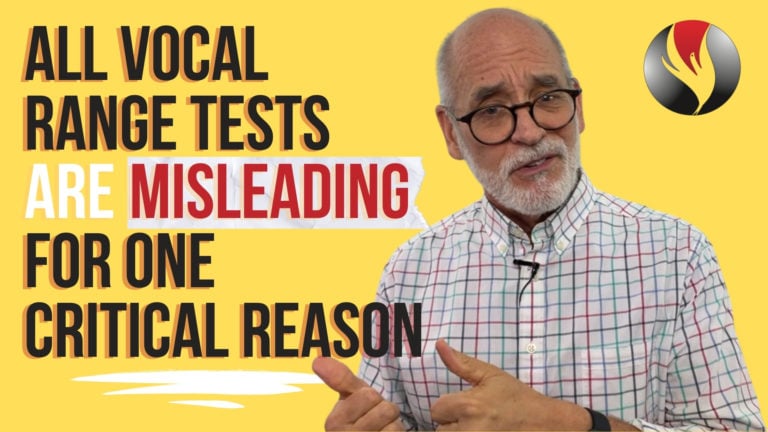Vocal Type vs Vocal Classification? What’s the difference?
Vocal Type vs Vocal Classification. There’s actually a big difference. Inside this video learn the difference and why it’s important to your singing.
I’ve just completed 103 video episodes about vocal technique and singing. Along the way many of you have asked questions about singing.
In the coming weeks I’d like to answer your questions. Please submit your questions in the comment section below this YouTube video or on my Vlog at PowerToSing.com.
Vocal Type vs Vocal Classification
Definition of Vocal Classification
Let’s talk about the the definition of “Vocal Classification”.
Your vocal classification is the quality of your singing voice determined by several things including your tessitura, timbre and range.
Your tessitura is the most musically acceptable and comfortable range for your voice… the range in which your voice presents its best-sounding texture or timbre.
This is generally in the range where you speak. It’s usually about four notes higher than the lowest note in your singing range.
Your timbre (/ˈtæmbər/ tam-bər) is your vocal tone color or tone quality of your voice.
Your Range is the pitches you can sing from the lowest to highest.
Here are two wikipedia links about voice classification in classical and non-classical music:
https://en.wikipedia.org/wiki/Voice_classification_in_non-classical_music
https://en.wikipedia.org/wiki/Voice_type
I don’t classify voices on my website for several reasons. First in opera and classical genres, the classifications of soprano, alto, tenor and bass have many sub-classifications.
Outside of opera and classical singing, these sub-classifications don’t apply to pop, musical theater (generally), rock, R&B, gospel, jazz, indie and etc.
Also, (as of this video) I’m not experienced enough in classical and opera to designate a vocal classification which also helps the singer understand which opera and roles in the opera their vocal classification is best suited. (That’s a mouthful) For example a coloratura soprano may be more vocally suited for Mozart’s rather than Wagner’s operas.
Second, a voice changes over time. For example, I’ve had many students who thought they were basses because they couldn’t sing past the E above middle C. Within a few lessons they learn to sing through the first bridge into their head voice and discover a whole new area and range in their voices. The same is true for many female students who increase their range.
Also, when the voice get’s balanced, it changes and improves. There’s less tension and more release in the voice. The tone quality, timbre and even the tessitura finds it’s vocal “home base” so to speak.
Of course I can tell you your range but it often increases as your lessons progress.
In his book, Singing for the Stars, Seth Riggs says: “I don’t [classify singers]. At least not right away. It’s wrong to prematurely classify a voice before you really get to know what it can do. Too often, existing range is the sole determining factor in placing a singer into a certain category. The most important factor to consider is the basic quality of the voice. Assuming that your speaking voice is clear and unforced, your singing voice should be based on the quality of that speaking voice. (pp. 76)
Vocal Type vs Vocal Classification
Definition of Vocal Type
Let’s talk about the definition of “Vocal Type”.
I define “vocal type” as a description of what you tend to do when you sing higher through the first bridge of your voice and into head voice. If you tend to pull your chest voice or if the larynx tends to rise, then you are the Pulled-Chest/High Larynx vocal type.
Other vocal types are Flip-Falsetto, Light Chest-No Chest and Mix. Each of these describe your “Tends To” or what you tend to do when you sing higher.
This is important for you to know about your voice. Once you know your vocal type, you can find exercises in my website, PowerToSing.com inside the Knowledge Center. These exercises are designed to correct the wrong things you tend to do, and quickly balance your voice.
Balancing your voice gives you the ability to quickly eliminate vocal weaknesses which improves your singing voice.
If you don’t know your vocal type you may waste a lot of time on exercises that cause you to continue doing the wrong things.
If you do the exercises as demonstrated in PowerToSing.com they’ll cause you to stop pulling chest, stop the rising larynx, stop the flipping and cracking and develop more power in your voice.
Discover your Vocal Type
If you haven’t yet discovered your vocal type, go to PowerToSing.com and take the vocal test, which I call the PowerTest. Take the quiz and discover your vocal type. Then visit the Knowledge Center and learn about your vocal type.
Download the free exercises and start improving your voice immediately.
I’m Chuck Gilmore with Power To Sing. You can sing higher with beauty, confidence and power.
I’ll see you inside the next video.










Responses
Hi Nanette: No. There are great singers out there who don’t read music. But there are very few who are serious singers who will let that continue. They will learn how to read music. Just taking piano lessons will help immensely!
Is it necessary that u can read musical notes in order to be able to sing well?
Hi Al: Thanks for your comment. You are exactly right about medicine. You will gain greater ability to reach the low notes when your voice is balanced. Particularly as the larynx settles and stays at speech level you will find the vocal cords coming together easier and more firmly even in the lower ranges. If the larynx is high, it is difficult to sing the lower notes of your range.
Knowing your vocal type is like having a “diagnosis”, once you know it you can apply the right “medicine” and your site really helped me figure that out. I also have a question about low notes. How can one strengthen the low notes of his/her range. I mean the pitches B2 to A2 and below if any. They seem to disappear in phrases. Thanks.